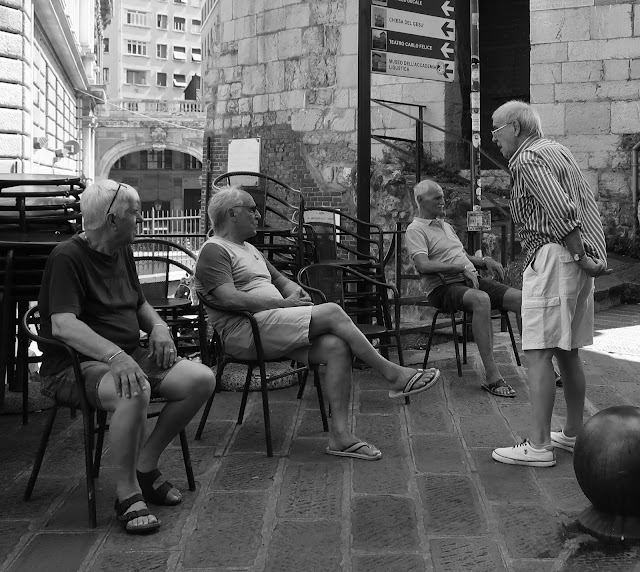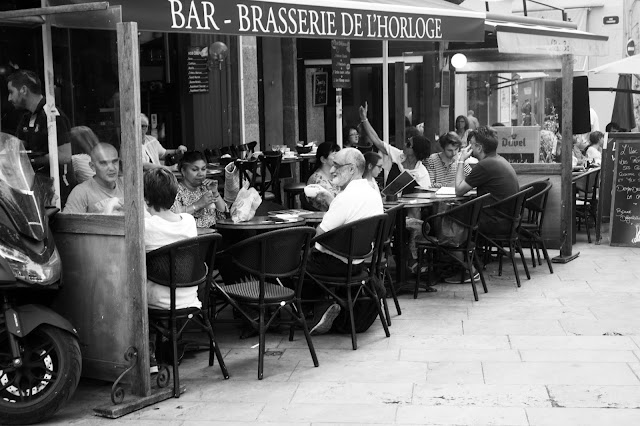 |
| A photo I took in Provence. |
The Wonder of Black & White Photography
Don’t worry; I’m not going to bore you with photographic jargon and detailed explanations of shutter speeds, aperture, and ISO. For that you can find any number of experts with far more experience and knowledge in the technical aspects of camera settings.
What I will attempt to do is introduce you to one of the finest black and white photographers, Henri Cartier-Bresson (1908-2004), show you some examples of his work, give you his philosophy of photography in his own words, then show you some of my work, not for reasons of arrogance, and certainly not to compare my work to a genius in the field of black and white photography, but to let you see that with little instruction, some courage, and without more than a sparse knowledge of the finer aspects of clicking a button on your camera, you can come up with some rather amazing photographs. Hey, if I can, you can!
Bresson, didn’t drape himself with photographic paraphernalia. He used a small camera, with one fixed lens. But, the equipment photographers need is very much dependent on what they’re going to photograph. Sports photographers, for example are loaded down with tripods and a variety of lenses that cost as much as a family sedan.
But, Bresson photographed life; simple life, mostly composed of people and situations, dependent only on geometry, composition, persistence and without hesitation.
In this short blog I’m not going to talk extensively about composition, but you can read about “the golden ratio” here: https://photographyhero.com/golden-ratio-photography/
Now, on to Henri Cartier-Bresson!
The creative act lasts but a brief moment, a lightening instant of give-and-take, just long enough for you to level the camera and to trap the fleeting prey in your little box. ---Henri Cartier-Bresson
To me that is one of the greatest instructions in all of photography, summed up by: Take the shot or lose it forever!
A couple of examples of his magnificent work.
And from my own experience: A close friend of mine, and much better photographer than I, were strolling the streets together on the left bank of the Seine River, in Paris. At the same instant we spied a bread man making a delivery, looking so Parisian, floppy blue work jacket, two-day beard, dark hair carelessly combed, walking with a large bundle of fresh baguettes under his arm. She and I grabbed our cameras at the same time, but both of us were a second too late! He walked past within two feet of us and we missed the shot! Neither she nor I will ever forget. Take the damn shot!
It is life that interests me and therefore always the next photo.
--- Henri Cartier-Bresson
Have you noticed that the most interesting photos are invariably candid? Even when I’m shooting group gatherings, I find a rare moment or two when I can use candid shots to capture more of the personalities. And black and white photos highlight life’s drama and intensity, discarding distracting arrays of colors to keenly focus directly on the subject. When the subject is a group of people, candid black and white presents a tableaux of faces, emotions, frozen in the exact moment when individuals are no longer a group, but once again individuals, clear and distinct. Black and white exhibits the solemn power of concentration. In a color photo of a field of wildflowers, one sees the field and brilliant colors, but with black and white, one’s eyes are drawn to a particular flower.
Photographs in B &W also pick up the details of everyday life, things you would never have noticed suddenly take on a thought provoking importance. A pair of shoes. The intricate gnarl of a ravaged tree, the careless beauty of a flower, and so much more. Far from taking away from the form and action, black and white photography accelerates comprehension with a single, intensified glance.
Try it and see if you see what I see. In Bresson’s case, nearly all of his best photos are candid and he was particularly taken with humans in motion and from unusual angles, with the human as part of the design.
Man. Man and his life, so short, so frail, so vulnerable. For my part…I am almost exclusively concerned with man. I cut straight to the chase. Eternity is for landscapes. ---Henri Cartier-Bresson
Some more quotes from Henri Cartier-Bresson.
I am a visual man. I watch, watch, watch. I understand things through my eyes.
Photography is not a job to me, it’s just a fierce enjoyment; you have no expectations, you wait for the surprise…
To me, film has nothing to do with photography. Photography is a visual thing that can be seen in a plane, like a drawing, a lithograph, or a painting. Film is a discourse.
And now a random few of my own B & W photos, that no doubt fall far short, but they give me hope! Like Henri, I tend to concentrate on people, but for me it's people in conversation. Here then are some of the times when I took the shot!
Tomorrow, I will show more selections of my efforts in B &W.




















No comments:
Post a Comment